If you’re protecting your home and family from threats that are in your house — and it’s dark — how will you illuminate the intruders to ensure you can make the right shot on the right target? You gotta have a light for that bump in the night, right?
In the video below, Clint Smith of Thunder Ranch explains (@2:42): “Lights are pretty easy. I don’t shoot s*** in the dark. I think it’s a bad idea.” He also mentions he has a light on his shotgun so he can find the light switch.
Most TTAGers would agree, needing a light for self defense isn’t up for discussion. But which kind of light — weapons-mounted or handheld — is the right choice?
Not an Either/Or Question
For me and my home-defense setup, I want to be sure of what my target is, and a light helps me do that. It’s right there in the rules of basic gun safety, Nos. 1 and 4, “Always keep the muzzle pointed in a safe direction,” and “Be sure of your target and what’s beyond it.”
A light lets me identify a potential assailant, but if the light is attached to a gun, I may end up pointing it at a loved one before I can identify them. That is a bad thing.
I don’t want to unintentionally point my loaded weapon at someone I live with simply because it was too dark to see who is who. If I’m covering my wife or kids or cats with my pistol, they’re only 4.5 pounds of finger pressure away from getting shot. Not the right choice for me.
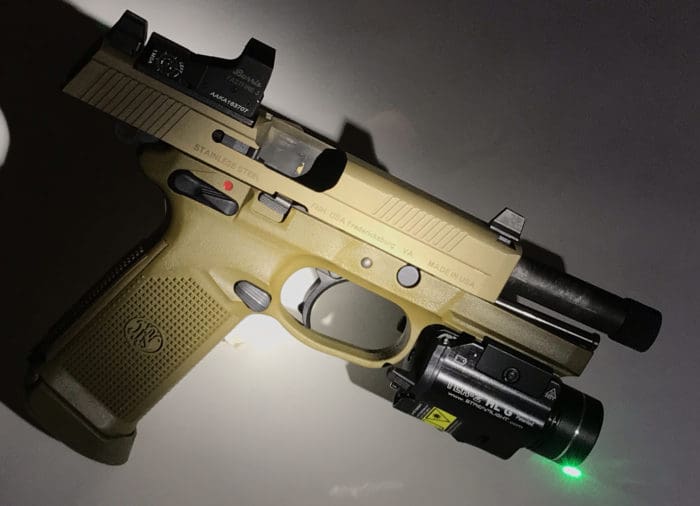
The alternative — getting a positive ID before muzzling a potential threat — obviously requires light, and too often, the issue is framed as, “Which would you rather, a gun-mounted light or a handheld light?”
This home-defense fight doesn’t have to be a Kobayashi Maru scenario, because I plan to win by whatever means necessary. So I’d rather have both self-defense tools.
A tactical flashlight has its tribulations, too, not the least of which is having to handle the gun with one hand while opening a door or using a less-familiar grip with the flashlight. The tactical FBI grip (where you hold the flashlight in the “ice pick” grip up in the air and away from your body) is probably the best known and has some law-enforcement imprimatur that does along with it, but the Harries, Chapman, and Neck Index flashlight techniques are also worth looking at. All have their pros and cons.
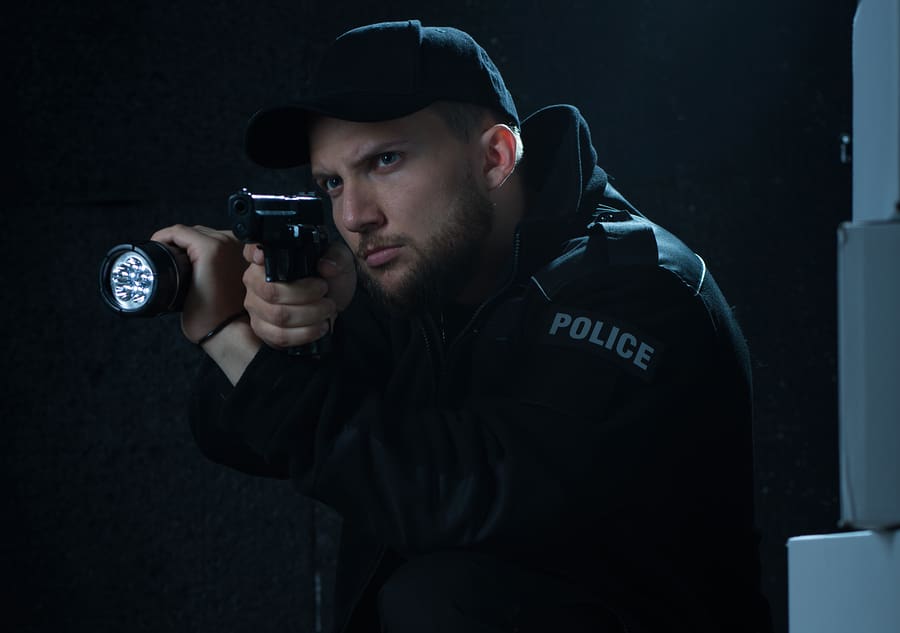
But to start, maybe I don’t have to use my tactical light or my weapon-mounted light (WML).
Ambient and Directed Lighting
My preference in terms of illuminating potential attackers in the house is for it to be bright enough with night lights so I don’t have to turn on my flashlight or weapon light. To that end, the common areas of my house have quite a few night low lights scattered around, which provides enough light for me to easily identify good guy/bad guy with no additional beams.
Also, the ambient light level is perfect for seeing the green laser I run on my FNX-45. As equipped, this rig is too big to use in a concealed-carry role, and the light makes holster fit impossible. So it lives in a quick-access safe.
Moreover, in addition to the ambient lighting, we extensively use Philips Hue wifi-controlled light bulbs through the house, which are programmed into my phone as zones. My wife or I (or adult children, if they’re on site) can switch on the lights all at once or in any zone in the house, or turn them off, from anywhere in the house. And I can operate the Hues while the phone is on and I’m talking to 911.
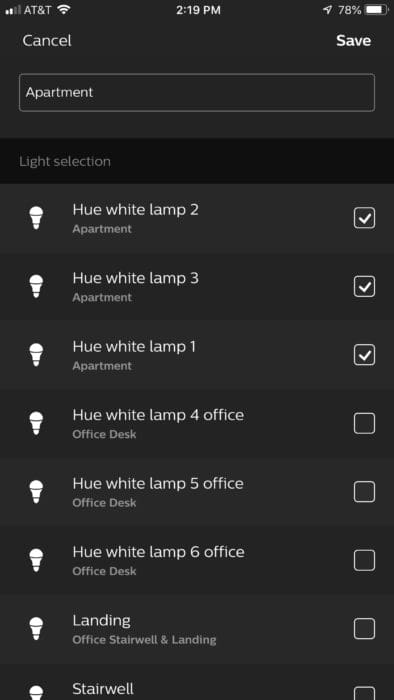
Would I be able to do all that with my shorts full of crap, as Mr. Smith so colorfully describes in many of his Thunder Ranch videos? I don’t know, but it’s nice to have the option.
Gun Lights
As I mentioned, I have a laser on my .45 ACP, but it’s really a light/laser combo, the 800-lumen Streamlight TLR-2 HL G. The high-lumen light simply slides onto the front rail of the FN and is secured with a screw, and it gives me both the white light I need to spot targets before dotting them with the Burris FastFire III optic or marking them with the green laser, which are co-witnessed at 15 yards. The WML runs on two CR123A batteries.
Many people believe they have to cover the target to illuminate it with a gun light. That’s not really true. The light can be activated off target, but in the target’s general direction, and the light turned on, either momentarily or locked on. Same is true with the laser.
I have to be careful with the bright Streamlight, making sure to point the light downrange and away from nearby items when I turn it on. If I accidentally point it near a light colored wall or other reflective surface, I’ll have a dark spot in my vision for a few seconds. That’s not the right strategy in a self-defense situation.
A few other considerations about a light source on a weapon:
- Having a gun-mounted light requires some way to attach it to the gun. The FNX-45 has a handy Picatinny rail that easily accepts the Streamlight. When I switch the laser/light to an AR or other long gun, the Streamlight mounts to the left-hand side of the gun and I can operate it the same way. I’m familiar with the on/off switch, the momentary on and strobe mode, and the feel of the bezel and housing.
- Lights mounted on your pistol’s rail cost more than a handheld light of equal brightness and build. Reason: They must squeeze illumination into a small package, mount directly to your firearm, have a switch that is easy to reach, be able to withstand recoil, and have a lens that will absorb muzzle blast and fouling without breaking or losing beam quality. That’s asking a lot, so expect to pay for it. I have a Streamlight TLR-3 (light only) as well and like it fine, and it’s only $80. It throws a surprisingly tight beam.
- Also, you’ve got to practice with the light mounted on the gun, both to ensure the light can withstand being attached to a pistol and because a light changes how a handgun handles. I shoot the FNX with the laser about 50 rounds a month and with the Fastfire optic the same amount with the light/laser attached. It gets dirty as heck after each session, so I clean the optic as well as the gun.
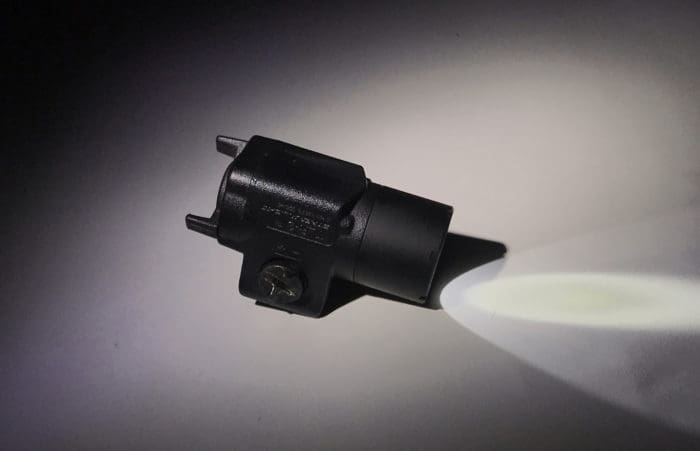
Handheld Flashlights and Penlights
There are other guns in the house, including a Benelli Nova 12-gauge pump gun and a Mossberg Model 500 Cruiser .410-bore pump which currently don’t have lights mounted on them. If I have to fall back to them, they’re stored with small, inexpensive Bass Pro Shops LED handheld flashlights with tailswitches.
The 6-Pack LED Combo package is only $10. They’re super-light and easy to operate. Click the tailcap switch that is operated with the thumb and they throw a less-intense (135-lumen) wide beam. Battery life (three lithium battery AAAs) has been stellar.
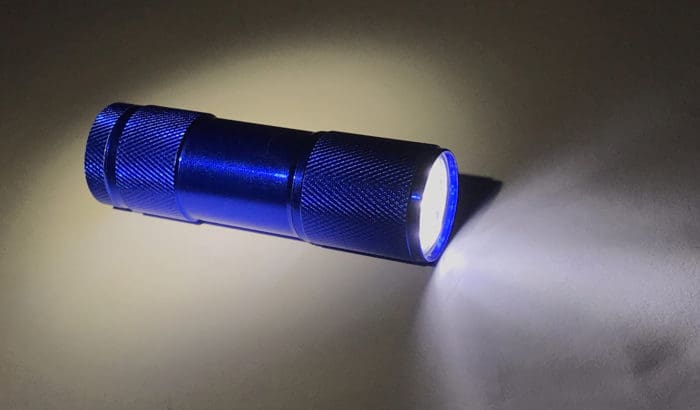
I can fit the lights into the forearm groove on the shotguns and still run the pumps. And, if needed, I can grab the light and look around a corner with it, and still fire one shot with either shotgun, though the Cruiser is a lot easier to handle.
There are a ton of tough, high-output lights with a range of features, including momentary switches, easy battery availability (such as AA or CR123), and reliability. The Surefire G2X Pro is affordable and suitable for home stowage, and as I mentioned, I like the inexpensive Bass Pro aluminum-housing lights for this specific use.
An extra-bright light can be useful, but I would never count on it to instantly blind someone in the house. That would be a great outcome. Same thing with a strobe function. I just need enough light to make sure the bump in the dark is a cat who lives here, not some Cat who doesn’t.
Also, I like these lower-powered backup lights because they don’t blind me. When I’m exposed to bright light, even if it’s reflected, I can’t see for several seconds. If I have fallen back to the shotguns after emptying the FNX-45 of its ammo (16 or 31) rounds of HPR 185-grain JHPs, the targets have been identified plenty good.
Power range for a handheld? Probably between 100 lumens to 450 lumens. The easy way to test it is to shine it around your house at night and see if you still have usable night vision after you shut it off.
Weapon Mounted vs. Handheld Light — What do you Use?
Do you use lights in your home-defense plan? Work your solution to the problem in the comments section below.
More about the use of tactical lights from The Truth About Guns:
Jeff Gonzales: How to Use a Flashlight for Armed Self-Defense Pt. 1
Jeff Gonzales: How to Use a Flashlight for Armed Self-Defense Pt. 2

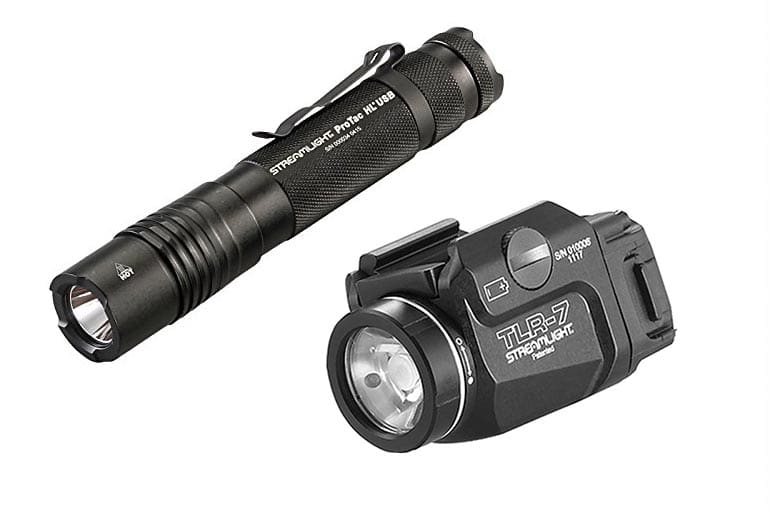


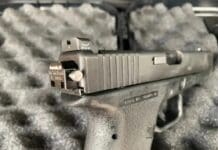
I prefer mounted lights / lasers. One less thing to carry and interfere with movement and hand use.
BUT…that being said, I have always wondered how good it is to have a light source pointing out MY center of mass.
Lasers are overrated. You focus too much on a dot instead of using your own skills. And if that little dot ever gets off-center due to a bump or normal bang-bang use of several hundred rounds through the barrel, it’s no longer reliable.
I have to tell you that sounds like a lot of old timey nonsense. The same arguments could and have in fact been made about iron sights and optical sights. Fortunately we live in a world where quality products actually exist that have largely relegated this argument that you are making to the dusty recesses of dusty minds.
1. Use both. Duh.
2. Anyone dumb enough to use the six pack of cheap bass pro flashlights must have a life worth about the same. Why even bother.
Agreed. This is why I don’t use Lasers.
I use weapon mounted lights and hand held tactical lights. Don’t like pointing my gun at stuff when in fight mode just to see what it is. Just because you have em doesn’t mean you have to use them both or at the same time.
YOU MUST HAVE A PROPERLY FITTED LANYARD on your hand held light IF you want to use your off hand to open doors, clear weapons malfunctions, etc without dropping the light. CLINT TAUGHT ME THAT!
Any decent weapon light is going to obliterate your night vision if have to use it in the middle of the night. Use it just to look around and you’ll have to keep it on, or else you’re blind until further notice. IMO, flip it on only to illuminate and double-sure identify the target you’ve already spotted. And to blind your target as well.
If no target is in sight (i.e. what was that noise?), use a low powered handheld to look around. Or nothing at all, if your eyes are adjusted.
Trits on pistols, end cap button mini-mags mounted on the long/shot-guns, motion sensor battery powered lights scattered round the house.
“Government spybox, turn on the lights…”
“playing ‘Turn on the Lights’ by Future”
The idea of Illumination is fine but it’s a two- edged sword; the assailant, upon seeing the light source, will immediately open fire on the light source – it’s a split-second tactical decision that any assailant would automatically make as a knee-jerk reaction to all of the sudden being illuminated.
I’m more in favor of night glasses, but then again how many people really have night classes sitting at their night table when they go to bed. Always remember, by using a flashlight the person you’re pointing at will immediately be able to zero in on a Target which is, unfortunately, your flashlights and you.
Hmm. First time I’ve ever seen NVGs referred to as “night glasses”.
I’d much rather flash some light on my potential target for positive identification before making any decision to pull the trigger. A finicky District Attorney would just *love* to ask why you didn’t positively identify your target to ensure you were actually in mortal danger before killing him.
The purpose of a flashlight is not to walk around with it on. Mine just uses my finger to flip it on and off. My trigger finger is not on the trigger either so that works. Its blinding to have it pointed at you in a house at night
“…upon seeing the light source, will immediately open fire on the light source…”
Yup, why you hold the light in your off hand a foot or more from your torso…
(At 8 AM, Tue. morning, that hurricane is predicted to be about 20 miles north of where I am. When the power likely goes out, it’s gonna hot and miserable here for a few days. I might have to get off the wagon for this one…)
Geoff, if it’s only for a few days consider yourself lucky. Last October I didn’t have power for 2+ weeks. Good luck. Keep a rifle and at least one handgun at the ready. With spare mags. Along with everything else. The panhandle is holding its breath. When she crosses the peninsula into the gulf it’s anyone’s guess.
I’m a little north of Tampa . near the coast, if it crosses over to the very warm gulf it could be trouble. BTW no water for sale here for last few days.
No power for a few days after the ’94 Northridge Quake wasn’t fun, but at least it was in January, which is ‘nice’ for us here in CA. I don’t envy the muggy heat you might have to endure.
All the best to you. Report back when you’re online again and let us know how your area made it through.
Working a job where I use handheld and weapon mounted lights while taking defendants into custody, this kind of response always gives away that someone has never used light to control a suspect. Please don’t spread inaccurate information if you have never taken training for low light conditions or have not used them properly in real world situations. Use a light so bright that the only thing the person being illuminated will want to do is cover his or her eyes because the light will go through the eyelids. Conveniently enough this shows their hands and anything in it. I’ve had people try to shoot the light source using a red gun, they can’t. Their overwhelming reaction is to protect their eyes.
As with anything, there is far more to a subject than first appears. Carry more than one light, carry a quality light that is insanely bright, and have a separate light for administrative tasks. Night vision is a whole separate can of worms with a different set of problems.
Lilduke, damn good advice. A number of years ago I took a light class at the High Liability Training Conference. Surefire, Streamlight? I don’t remember. It was illuminating. (Sorry, I couldn’t resist.) Bright light in the eyes. They flinch. Same reason I carry my keys in my left hand in a parking lot. Toss them at the dirtbag’s face as you draw. See what happens.
I have multiple Olight weapon-mounted and handheld lights because of their performance, features, and price. I’m not affiliated with Olight, but they have their new Seeker 2 handheld 3,000-lumen rechargeable light on flash sale today for only $77.
I use their compact PL-MINI 2 Valkyrie weapon light (600-lumen, rechargeable, $90 MSRP) for EDC pistol and PL-2RL Baldr weapon light (1,200 lumen + red laser, $130 MSRP) for home defense pistol. Also have various handheld Olights placed around the home. I plan on getting the PL-Pro Valkyrie (1,500 lumen, rechargeable, $130 MSRP + $30 magnetic remote pressure switch) next time they go on flash sale (Olight flashsales are usually 30%-40% off.). These lights also have lower lumen output modes if you want that for indoors.
What other manufacturer offers better combination of performance, features, and price?
Wow, Skorp. For not being affiliated, you sure do sing their song nicely.
I have Olights as well. On my nightstand Glock, in my drawer, and in fact their “mini” in my pocket right now. I have a Valkyrie mounted on the Glock, as well as a separate hand-held flashlight in case I only need to cast some light on something in the hallway during an overnight power failure (it happens perhaps once a year) and I don’t want to be pointing my gun.
I took a nighttime gun course earlier this year in which practiced both the hand-held and weapons-mount methods.
All the table and standing lights in my house are connected to my alarm. If the alarm is activated, all lights immediately turn on. If the power is out, I have battery lights in the hallways that turn on when they detect power loss.
I keep two handheld lights next to my pistol. WML on work pistol only.
I mounted a light on my AR on the UTG dropin handguard I got. TacLite from Wallyworld. I got a WW flashlight for my handguns. Not mounted. Both will blind the he!! out a home invader. My gunshop guy has a TR -3 on his handgun and I might get one. Very nice! I disagree about lights-a laser will give you away immediately. What kind of red dots does everyone have? That’s my next move…anyone use TruGlo or those cheap Axeon Tricyclon sights from Wal-Mart???
I only use a handheld flashlight for several compelling reasons:
(1) A firearm mounted flashlight shows an attacker EXACTLY where to shoot.
(2) A firearm mounted flashlight eliminates any advantage of cover or concealment.
(3) A handheld flashlight on the floor in a strategic location is very useful.
(4) Guests and even children can borrow my handheld flashlight any time.
(5) I have a high degree of confidence that my handheld flashlight works because I use for other tasks all the time.
Somewhat related:
If I have a firearm in hand I am already in an extremely precarious situation. Therefore, I want operation to be as simple as possible and my tasks to be as simple as possible. I want to be able to use the full processing power of my brain to evaluate the situation and not have to apply thought to the location and function of the flashlight on my firearm.
I carry a small handheld regardless of having one on the pistol. A weapon light shouldn’t be used for general illumination.
I am always surprised by people who say you shouldn’t use a light because the bad guys can see it.
No shit! But if YOU can’t see, you shouldn’t be shooting. Period.
Knowing when to turn it off and on is an adult activity. Play at your own risk.
I have an Olight for my PT111G2 that is mounted when I use it as a night stand gun. It comes off when I carry the Taurus, I instead rely on a streamlight pen light. It’s only 90 lumens but convenience means I will actually carry it. Kinda the same reason my Remington RM380 gets carried more than the Taurus despite its limitations.
Both is the correct answer to this question. There are multiple ways a hand held can be employed tactically (lay it on the ground to create cover at night, use it in the daytime to create temporary cover or throw off a person’s OODA loop, etc.). A weapon light is also capable of disrupting an OODA loop – a particularly blinding light can have the same temporary effect as being shot. They are both useful in various scenarios. Unless your budget or skinny jeans prevent you from doing so, carry both.
Good article. Two lights. Hand held and WPL. Drop hand held after confirming locations of loved ones. All others get the muzzle. No thanks to the lasers. In my opinion over rated. Unless you have NCG. Then you see the whole beam.
BOOM!
Gadsden and I are on the same page on all counts. We’re “weapons light” twinsies.
You need both types of flashlights. A Handheld to ID and investigate and a WML to engage a threat. Each light has a different purpose much like your pistol, rifle or shotgun, which should all have lights. A pistol should be carried and used to fight your way to a rifle. I am not a laser fan, they teach you to focus on the target and not the front sight and given how much play exists in the rail to light interface they don’t really have a reliable zero. Yes, Some are better than others: metal rail to metal laser/light vs plastic rail to metal laser/light. If you use a laser as an intimidation device you have violated two of the cardinal safety rules. Not a sermon just my thoughts.
Pssh, real operators have helmet-mounted lights (infra-red ones) 🙂
For folks who think that using a weapon mounted light requires pointing the muzzle at your target, try this experiment. Grab any reasonably bright flashlight, go into your bathroom with the lights off, and close the door. Turn your flashlight on and hold it so that the beam is pointed as it would if it was a weapon light held at the low ready position. Look at yourself in the mirror. Yeah.
As for the notion that a light will give your position away, that’s true, but how relevant is that if you’re using it intelligently? If you’re clearing a house, you have to be ready for the bad guys to start shooting the moment you peek around every corner whether you have a light or not. Unless they’re deaf or you’re some kind of super ninja they’re probably going to hear you approach, and they don’t care about identifying their target. Ears are useful. On that note, get yourself some decent electronic hearing protectors. They’ll amplify sounds and allow you to continue hearing after shots are fired. Personally, I don’t plan to leave the bedroom unless I have time to get fully armed and armored, but I don’t have kids to protect. Do what you must.
Lasers aren’t useless, but they’re not as useful as Hollywood and video games would lead you to believe. Expect any handgun mounted laser, whatever the color, to be useless in sunlight or at range. They can certainly aid you in point shooting indoors at close quarters, but frankly so will most weapon lights. Humans are big.
I use light switches mounted on my walls to illuminate rooms in my house. I have a dog that barks at strangers and an alarm system, so if either go off, I’m at the top of the stairs with one hand on my home defense weapon and the other on a light switch.
Oh, and lasers don’t give your position away until after there is enough smoke in the room for the laser to light up. Until then your eyes have to be within a few degrees of it to see the light coming from it towards you. I’ve never had a laser get loose when mounted to a pistol, but I’ve always used Crimson Trace products.
If your home is lit up by small lights or a lot of ambient light you are giving up an important advantage. The last thing you want to do is light up your home so the bad guys can move around easily and see. You can navigate your home in the dark much better than someone who doesn’t know your floor plan. Don’t destroy one of your advantages.
“the common areas of my house have quite a few night low lights scattered around”
We’ve been doing this for over 30 years. It works very well. With the newer LED lights being so inexpensive to purchase and operate, it isn’t even noticeable in the wallet; on the electric bill or at the hardware store. Some friends used to think it was daft. Now I notice some of them with similar setups.
Mounted for home defense.
I use my cellphone light outside of the house – I don’t need crap hanging off my concealed carry pistol and frankly, I’m not clearing rooms and breaching / invading property in my day to day activities.
You do not need to point a weapon mounted light to identify someone. My modest Streamlight TLR-1 illuminate the whole room at low ready position.
I have a handheld backup also because why not, but you can still be safe with just a weapon light.
Comments are closed.